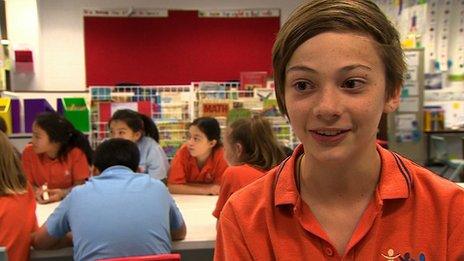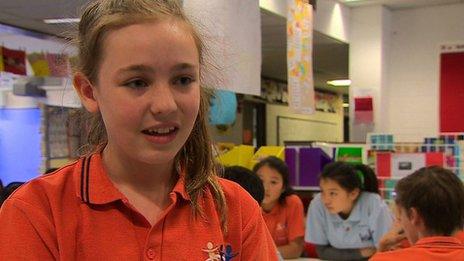Meet the Australian children fluent in Mandarin
- Published
Five-year-old Jackie Baldwin can give her name in Mandarin
Australia's politicians often talk about the importance of building ties with Asia. Successive governments have promised to increase the number of schools teaching Asian languages, but in fact the number of children in high school learning Asian languages is falling. The BBC's Jon Donnison has been to one of the country's few bilingual schools.
Sitting cross-legged on the floor of her classroom, chewing on the end of her pen, five-year-old Jackie Baldwin is deep in thought.
Blonde haired, with pink spectacles balanced on the tip of her nose, her hand begins to move steadily and confidently across her page, leaving a neat line of Mandarin Chinese characters.
Among them I spot the letters "BBC" in the English alphabet.
"Today the BBC is visiting our school," Jackie says, helping me out with the translation.
She is part of the bilingual English and Chinese immersion programme at Richmond West Primary School in Melbourne.
Like most of the 23 children in her class, Jackie has only been learning Mandarin for a few months but to see her chatting and playing with her friends in a mix of English and Chinese, you would not know it.
"The younger they start learning Chinese as a second language, the easier it is for them to learn," says Kim Lim, an effervescent teacher who has been at the school for around 20 years.
"They are like sponges, socially and mentally they just easily absorb things. Learning a second language comes naturally."
Grips with Mandarin

Harry Flynn Kitchen said people were surprised when he spoke Mandarin in China
The school is state-funded and is not in a well-off neighbourhood. It has children from 23 different ethnic backgrounds.
Some of them are children from countries in Asia who have been adopted in Australia and brought up speaking English as a first language. They are now getting to grips with Mandarin.
Two days a week, it is total immersion in Chinese, with all classes being taught in the new language.
The school also has a similar, although less extensive, programme in Vietnamese, which it wants to expand.
By the time the children studying Mandarin leave the school after six years, they can expect to be fluent in both reading and writing.
"This school is a treasure," says Dr Jane Orton, director of the Chinese Teacher Training Centre at the University of Melbourne.
"There are kids here, little blonde blue eyes and if I shut my eyes, I wouldn't know they weren't Chinese. It really shows that it can be done and that's what people need to see."
Some of the older children at the school recently got to take part in a field trip to China organised by a group of parents.
The students say they got a good reaction.
"When I went into a couple of two-dollar shops over there and said, 'How much is this?' and 'Thank you', they were like, 'Wow you speak Chinese!'" says Harry Flynn Kitchen, 12.
"They were very surprised," says Georgia Kellet, also 12. "It's not often they get to see a girl with blonde hair talking fluently in Chinese."
Exception to the rule

Georgia Kellet, 12, can speak fluent Mandarin
If all schools were like this in Australia, you could imagine the country would be well on its way to be multilingual. But Richmond West is very much an exception.
"If you thought this was typical, it's not," says Lloyd Mitchell, the school's principal.
"There would probably be less than 10 schools across the country that are teaching bilingual immersion programmes in an Asian language."
Dr Jane Orton says Asian languages are taught in many primary schools but only for half an hour or so a week, which is nowhere near enough to get a proper grasp of a language.
It means when children move on to high school, there are very high drop out rates for Asian languages because many simply feel they have not progressed or it is too difficult.
The dropout rate at high school for Chinese is around 95%.
And all that is despite the fact that successive Australian governments have made big pledges to try and increase the number of children studying languages.
The former Labor government proposed that every Australian high school child should be given the opportunity to learn an Asian language by 2025.
The current government says 40% of high school children should be learning a foreign language in 10 years' time. The figure is currently only around 12% in the final year of high school.
Some have accused the politicians of empty promises.
"It's nonsense. It's not only unachievable. History has shown that it's not even going to be taken seriously," says Mr Mitchell.
"We put these aspirational goals out there and then we sit back and just hope it happens. These things don't happen by osmosis. The discussion papers are there, the rhetoric is there, but the action is very slim on the ground."
Some have suggested that to reach the 40% target by 2023, it could cost around A$2bn ($1.9bn, £1.2bn).
"It would require targeted spending and investment and vision," says Dr Orton.
"It's going to take longer than three years, the election cycle. But at the moment, I don't see a strategic plan in place to do it."
The children at Richmond West should leave the school on the right track to play a role in what is often called the Asian Century.
But they are a small minority.
Most Australians seem to recognise the economic importance of engaging with Asia.
"The capacity to engage with Asia is so great in terms of business, intellectual property, culture. If we don't seize that opportunity, somebody else will," says Mr Mitchell
"I believe other countries are working harder than we are to achieve those goals. Unless we take some brave action, Australia will miss out."
- Published17 September 2012
- Published28 October 2012